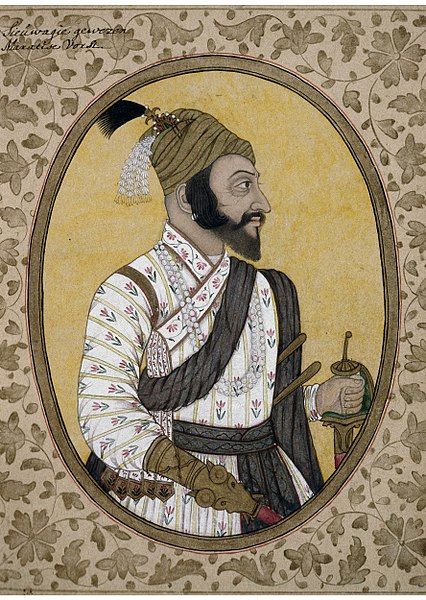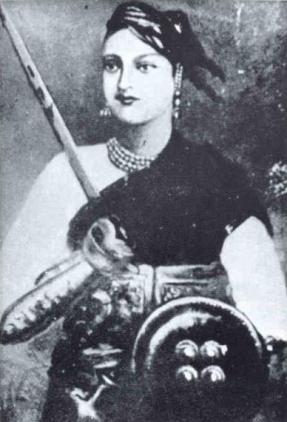Shivaji Bhosale I (Marathi pronunciation: [ʃiʋaˑɟiˑ bʱoˑs(ə)leˑ]; c. 1627/February 19, 1630 – April 3, 1680[5]) was an Indian ruler and a member of the Bhosale Maratha clan. Shivaji carved out an enclave from the declining Adilshahi sultanate of Bijapur that formed the genesis of the Maratha Empire. In 1674, he was formally crowned as the Chhatrapati (emperor) of his realm at Raigad.
Over the course of his life, Shivaji engaged in both alliances and hostilities with the Mughal Empire, Sultanate of Golkonda and Sultanate of Bijapur, as well as European colonial powers. Shivaji's military forces expanded the Maratha sphere of influence, capturing and building forts, and forming a Maratha navy. Shivaji established a competent and progressive civil rule with well-structured administrative organisations. He revived ancient Hindu political traditions and court conventions and promoted the usage of Marathi language.
Shivaji's legacy was to vary by observer and time, but nearly two centuries after his death, he began to take on increased importance with the emergence of the Indian independence movement, as many Indian nationalists elevated him as a proto-nationalist and hero of the Hindus.
Early life
Main article: Early life of Shivaji
Shivneri Fort
Shivaji was born in the hill-fort of Shivneri, near the city of Junnar in what is now Pune district. Scholars disagree on his date of birth. The Government of Maharashtra lists 19 February as a holiday commemorating Shivaji's birth (Shivaji Jayanti).[a][16][17] Shivaji was named after a local deity, the goddess Shivai.[18] Shivaji's father Shahaji Bhosale was a Maratha general who served the Deccan Sultanates.[19] His mother was Jijabai, the daughter of Lakhuji Jadhavrao of Sindhkhed, a Mughal-aligned sardar claiming descent from a Yadav royal family of Devagiri.[20][21]
At the time of Shivaji's birth, power in Deccan was shared by three Islamic sultanates: Bijapur, Ahmednagar, and Golkonda. Shahaji often changed his loyalty between the Nizamshahi of Ahmadnagar, the Adilshah of Bijapur and the Mughals, but always kept his jagir (fiefdom) at Pune and his small army.[19]
A statue of young Shivaji with Jijabai installed at the fort of Shivneri in 1960s
Upbringing
Shivaji was devoted to his mother Jijabai, who was deeply religious. His studies of the Hindu epics, the Ramayana and the Mahabharata, also influenced his lifelong defence of Hindu values.[22] He was deeply interested in religious teachings, and regularly sought the company of Hindu saints.[23] Shahaji, meanwhile had married a second wife, Tuka Bai from the Mohite family. Having made peace with the Mughals, ceding them six forts, he went to serve the Sultanate of Bijapur. He moved Shivaji and Jijabai from Shivneri to Pune and left them in the care of his jagir administrator, Dadoji Konddeo, who has been credited with overseeing the education and training of young Shivaji.[24]
Many of Shivaji's comrades, and later a number of his soldiers, came from the Maval region, including Yesaji Kank, Suryaji Kakade, Baji Pasalkar, Baji Prabhu Deshpande and Tanaji Malusare. Shivaji traveled the hills and forests of the Sahyadri range with his Maval friends, gaining skills and familiarity with the land that would prove useful in his military career. Shivaji's independent spirit and his association with the Maval youths did not sit well with Dadoji, who complained without success to Shahaji.
In 1639, Shahaji was stationed at Bangalore, which was conquered from the Nayaks who had taken control after the demise of the Vijayanagara Empire. He was asked to hold and settle the area.[28] Shivaji was taken to Bangalore where he, his elder brother Sambhaji, and his half brother Ekoji I were further formally trained. He married Saibai from the prominent Nimbalkar family in 1640.[29] As early as 1645, the teenage Shivaji expressed his concept for Hindavi Swarajya (Indian self-rule), in a letter.
Conflict with Bijapur
In 1645, the 15-year-old Shivaji bribed or persuaded Inayat Khan, the Bijapuri commander of the Torna Fort, to hand over possession of the fort to him.[34] The Maratha Firangoji Narsala, who held the Chakan fort, professed his loyalty to Shivaji, and the fort of Kondana was acquired by bribing the Bijapuri governor.[35] On 25 July 1648, Shahaji was imprisoned by Baji Ghorpade under the orders of Bijapuri ruler Mohammed Adilshah, in a bid to contain Shivaji.[36]
According to Sarkar, Shahaji was released in 1649 after the capture of Jinji secured Adilshah's position in Karnataka. During these developments, from 1649–1655 Shivaji paused in his conquests and quietly consolidated his gains.[37] After his release, Shahaji retired from public life, and died around 1664–1665 in a hunting accident. Following his father's release, Shivaji resumed raiding, and in 1656, under controversial circumstances, killed Chandrarao More, a fellow Maratha feudatory of Bijapur, and seized the valley of Javali, near present-day Mahabaleshwar, from him.[38][39]In addition to the Bhosale and the More families, many others including Sawant of Sawantwadi, Ghorpade of Mudhol, Nimbalkar of Phaltan, Shirke, Mane and Mohite also served Adilshahi of Bijapur, many with Deshmukhi rights. Shivaji adopted different strategies to subdue these powerful families such as marrying their daughters, dealing directly with village Patil to bypass the Deshmukhs, or fighting them. [40]






0 Comments